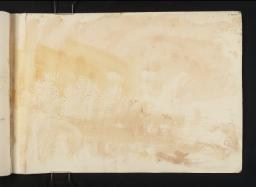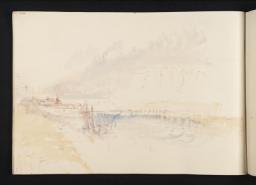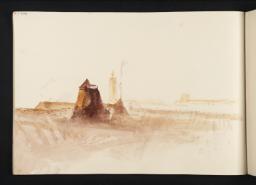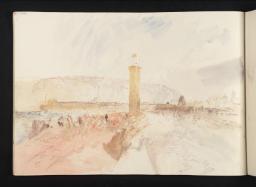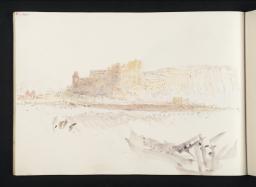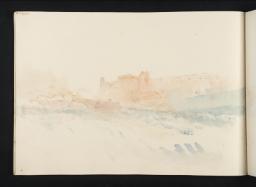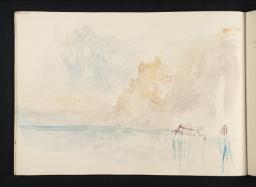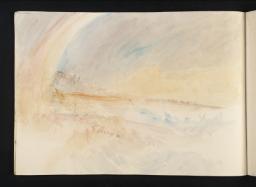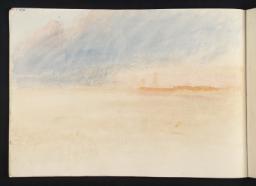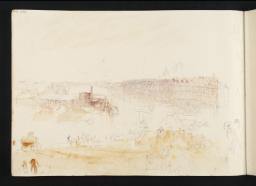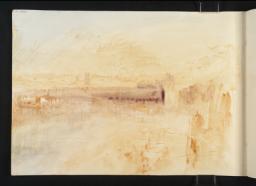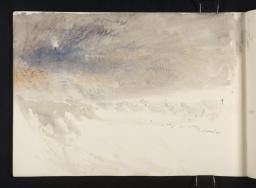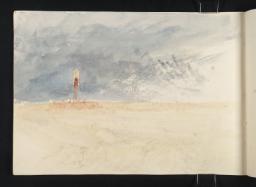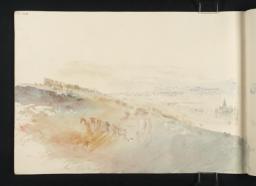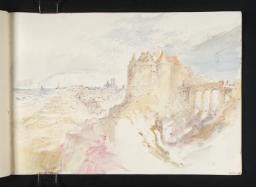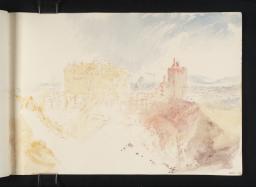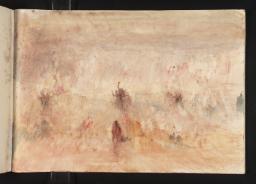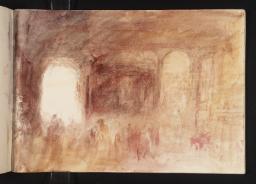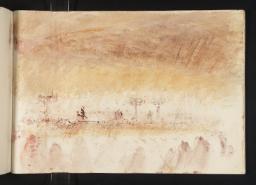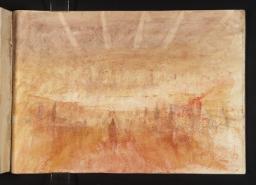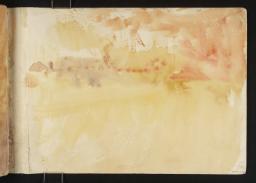Turner Bequest CCCLX 1–24
Roll sketchbook with green paper covers, with dark green cloth spine
22 leaves of white wove paper, approximate page size 230 x 330 mm
Various pages watermarked (see Technical notes)
Stamped in black ‘CCCLX.’ top centre of front cover
Inscribed in black ink ‘CCCLX.’ bottom right of front cover
22 leaves of white wove paper, approximate page size 230 x 330 mm
Various pages watermarked (see Technical notes)
Stamped in black ‘CCCLX.’ top centre of front cover
Inscribed in black ink ‘CCCLX.’ bottom right of front cover
Accepted by the nation as part of the Turner Bequest 1856
Exhibition history
References
The Dieppe sketchbook is one of the two known ‘roll sketchbooks’ that accompanied Turner on his Continental trip to northern France in September 1845, as discussed in the Introduction to this tour. Although the other sketchbook (Eu and Tréport; Tate; Turner Bequest CCCLIX) was entirely broken up in the twentieth century, this volume remains bound between the soft paper covers that allowed such items to be conveniently rolled up and carried about in a pocket.1 The sequence in which the sketchbook is catalogued follows the foliation established by Ruskin in the mid-nineteenth century, although the item had no designated front or back when acquired by Turner. This fact is reflected by the way in which the artist worked consistently through the volume in one direction, inverted it to record two views of Dieppe Castle, then flipped it again to resume the original sequence. The result of this action is that folio 17 recto (D35476; Turner Bequest CCCLX 18) and folio 18 recto (D35477; Turner Bequest CCCLX 19) appear upside down relative to the rest of these pencil and watercolour sketches of Dieppe and its environs.
In Harbour of Dieppe (Changement de Domicile) (Frick Collection, New York), a major oil painting for the 1825 Royal Academy exhibition, Turner had depicted Dieppe as a brightly shining fishing and cargo harbour, lined by imposing port buildings and bristling with masts and rigging.2 Although the town remained an important industrial centre,3 speedier cross-Channel services, the picturesque beauties of Normandy, and the popularity of sea bathing had since turned Dieppe into a favourite holiday destination for the English.4 By the mid-1840s, furthermore, the annual summer and autumn influx of fashionable French tourists, with their discriminating shopping habits and taste for the elegant sociability, had made of the town nothing less than a ‘petit Paris’.5
This newly fashionable and gaily bustling side to the town is but glimpsed in the Dieppe sketchbook. In folio 6 recto (D35465; Turner Bequest CCCLX 7), the handsome Bathing Establishment, or ‘Casino’, at the far end of the long beach is diminished to a small hunkering structure and omitted entirely from folio 17 recto (D35476; Turner Bequest CCCLX 18). Nevertheless, the views of the harbour in folio 11 recto (D35470; Turner Bequest CCCLX 12) and folio 12 recto (D35471; Turner Bequest CCCLX 13) pay particular attention to the quayside hubbub which, with its horse-drawn carriages and slim, elegantly inclining figures, suggests leisured company over industrial business. Generally speaking, the views of the harbour feature curiously little shipping, and show greater concern for the appearance of its infrastructure at various times of day; folio 5 recto (D35464; Turner Bequest CCCLX 6), for example, is a scene of blazing sunshine, while the lighthouse pierces the twilight in folio 15 recto (D35474; Turner Bequest CCCLX 16). The picturesque medieval castle to the west of the main town was clearly of the greatest interest, however.6 Turner traversed the long shingle beach and ascended the high chalk cliffs to capture the structure from several vantage points, making the most of its Romantic turrets, battlements, and high-arched approach bridge.7
As set out in the Introduction to this tour, there is evidence to suggest that King Louis-Philippe summoned Turner on this tour in order to record the events of Queen Victoria’s second visit to the Château d’Eu, some twenty miles up the coast from Dieppe. Four loose, warm-toned watercolour studies in the sketchbook depict grand apartments decorated with coffered ceilings and lit by tall arched windows and candelabra. Such features are consistent with the state apartments of the Château d’Eu, as detailed in the meticulous watercolours commissioned from Eugène Lami (1800–1890) by Louis-Philippe as a gift for Victoria to commemorate her 1843 visit.8 Especially comparable are Lami’s Royal Visit to Louis-Philippe: the Salon de Famille, Château d’Eu (Royal Collection) and folio 22 verso (D35484; Turner Bequest CCCLX 23).9
Martin Butlin and Evelyn Joll, The Paintings of J.M.W Turner, revised ed., New Haven and London 1984, pp.126–7 no.231, pl.234.
John Murray (ed.), Hand-Book for Travellers in France, revised ed., London, Paris and Leipzig 1844, p.23.
Paul André Lemoisne, L’OEuvre d’Eugène Lami (1800–1890) Lithographes-dessins-aquarelles-peintres. Essai d’un catalogue raisonné, Paris 1914, pp.116–20, nos. 495, 496, 498, 500, 502, 504, 506, 507.
Technical notes
How to cite
John Chu, ‘Dieppe Sketchbook 1845’, sketchbook, February 2014, in David Blayney Brown (ed.), J.M.W. Turner: Sketchbooks, Drawings and Watercolours, Tate Research Publication, April 2015, https://www

